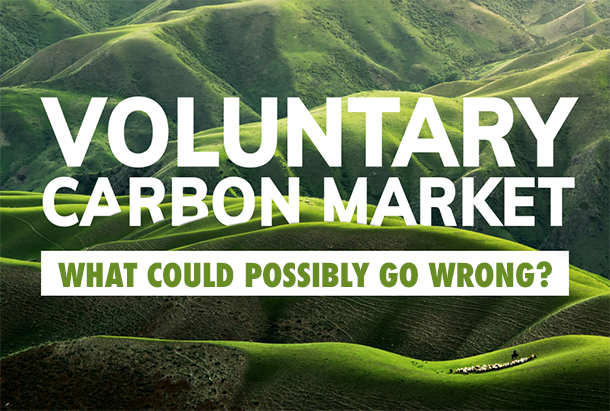The moral shortcut of carbon offsets generates real world harms for the indigenous Amazon tribes and rainforests which such schemes pretend to protect.

Blake Lovewell
21st Century Wire
I was recently lucky enough to be able to book a ferry from the UK to France. After years of stifling regulation on free movement, in August of 2022, one could finally travel across the English Channel without nasal swabs, without saliva tests; and without presenting government sanctioned barcodes. It only took us 3 years to get over the coronavirus paranoia and back to a calmer state of affairs. For that we should be thankful.
Now on the booking page for the ferry something caught my eye. It was an optional tickbox at the bottom of the form. It said: “Would you like to pay £2.50 to offset the carbon footprint for your journey?”. This piqued my interest and so I dug deeper. For starters, I followed the link provided to carbonfootprint.com. It explains the basics of a carbon footprint and the dogma of the greenhouse effect in excessively simple terms. In fact there are a number of typographical errors in their website. Here you can learn that: “Climate Change (also known as Global Warming) [has caused temperature rise] … with increasingly levels of human activity.” [sic]. It reminds me of projects in school where someone would copy and paste sections of text from a website and hand it in as their own work. Thus, I deemed this website no great authority on the subject.
However, this company registered an income of over £7 million in 2022 so far. This money comes from their carbon calculator service – which pretty much converts ‘miles travelled’ to ‘tons of CO2’ and then offers a byway into a carbon offset marketplace. In fact Carbon markets have expanded to over £250 billion in the last year, and the World Economic Forum points to it as the main means of fighting climate change1. This burgeoning carbon offset market is also being underpinned by the drive to force businesses into the new globalist corporate compliance scheme known as Environmental, Social and Governance (ESG), which is supposed to represent an organisation’s corporate financial interests which are meant to focus on “sustainable and ethical impacts.” All in all, it looks like a great business to be in right now – people will throw money at you to assuage their guilt over the nefarious carbon they emit just by existing. The ferry company simply offers a tickbox, funnelling money over to a middleman to purchase carbon offsets, also known as carbon credits, on your behalf.
So let’s dig deeper, into those services on offer…
While browsing in the carbon offset marketplace, we find pictures of happy Malaysian coffee farmers, shiny solar panelled roofs and scenic wind farms rising over rolling hills. From an environmentalist perspective, there is no question as to the efficacy of these projects – their mere existence is a Carbon offset. In theory, the amount of Carbon emissions saved by a wind farm is calculated as the amount of ‘clean’ energy generated versus how much CO2 would be generated using solid fuel generators. They do not take into account the high intensity coal burnt to melt the steel for the wind turbine’s huge fins, nor the multiple intercontinental lorries and boats to transport the hundreds of meters of steel poles to the site, nor the metric tonnes of electric components which make up the turbine’s generator, the interim power stations and giant transformers, and many miles of cabling. I posit that those factors might actually offset any supposed ‘gains’ from building such projects.
Now these ‘renewable’ projects make up only a small part of the carbon offset market. Note the quotation marks – yes, the wind and sun is renewable, but the steel, copper, rare earth metals, oil, natural gas and coal used to build these projects are far from renewable. Furthermore, it is not in the interest of the Carbon profiteers to include these exogenous factors in their calculation as it would eat away their profit, and rot their moral argument of ‘saving the planet’. As we dig deeper through the spongy loams of renewables, we find thicker clay below.
The biggest and most common Carbon offset schemes are simply forests. Most of the offerings in Carbon marketplaces are forests, particularly in East Asian, African and South American nations. This is no coincidence, since the 1970s and the inception of “Sustainable Development” the North-South divide on environmentalism has existed. The ‘North’ is made up of the industrial empires of the last two centuries, also confusingly referred to as ‘the West’. I always seek to avoid using the loaded terms ‘developed nation’ or ‘rich country/poor country’ as they embody that divisive and elitist ideology. But it is this ‘North’ which seeks to regulate the growth of the ‘South’ as they ascend the ladder of industrialisation. We will explore these themes further in Part two of the Carbon Credit Series. I will leave you with a quote from Brazilian Miguel Osório de Almeida in 1971 at the first Stockholm conference on climate:
“To be many and to be poor is offensive to the sights and feelings of developed countries. Most of their suggestions do not concern cooperation for increasing income, but cooperation to reduce numbers.” 2
Through this lens, the rosy photographs of rainforests feel more than a little phony. In fact there is a false logic behind these forest investment vehicles. The official Carbon offset offered by a forest is in fact the amount of CO2 the trees suck up each year, as they have for millennia. The only value being packaged and sold on these marketplaces is not cutting down the trees. Therefore, by not cutting down a forest, the company is maintaining a ‘Carbon sink’ and thus negating my ferry’s carbon footprint. One is paying the landowner for doing nothing. This logic has an acronym, and it is slapped all over these heralded offset projects: REDD. That is a UN scheme called ‘Reduce Emissions from Deforestation and Forest Degradation’. I would re-name it to, ‘Sell off indigenous forests to global investors’. Now if you think my take is too strong, let us drill deeper into the bedrock of the issue.
REDD projects say they protect forests. That is the value sold around the world through carbon markets. Yet, the truth seems a lot less green. In Indonesia for example, the Katingan REDD project has displaced indigenous farmers. Those farmers who use traditional farming techniques are no longer allowed into their ancient forest as it is now a global asset.3 It’s biggest creditor is Shell, the notorious multinational oil company. Shell themselves present the project as part of their green washing initiative with a heartwarming page on their website4. However, despite the claims to be protecting the forest, swathes of it are being converted to palm oil plantation amidst local corruption. This means that even as ancient hardwoods are displaced for quick-profit palm oil trees. Amazingly, they still count the same in carbon credit terms. All of this occurs whilst the forest had already been designated and protected by the Indonesian government decades previously. That is not enough for REDD, who take over control of the forest on behalf of their creditors. Most shockingly though is the fact that these REDD ‘protectors’ paid up by carbon markets, seemingly allowed huge wildfires to rampage through 9000 hectares of the Katingan rainforest, emitting tonnes of CO2 in the process. One investigator interrogated Verra, the carbon credit certification body about these wildfires:
“Dupont-Nivet asks whether Shell’s carbon credits will remain valid even if all of Shell’s “climate forest” goes up in smoke? “Correct,” Swickard replies. “We have done extensive analyses with scenarios and models to ensure robustness.” 5
Well, we can sleep well at night knowing that Shell’s carbon offset rainforest is being protected by “analyses with scenarios and models to ensure robustness”. And that the forest is safe in the hands of Permian Global, appointed by REDD to guard and protect their precious carbon offset forest. Permian Global is a Luxembourg-based finance firm created by ex-Barclays bankers, so these forests are in safe hands, I’m sure.

Get Clive de Carle's Natural Health essentials of the finest quality, including vitamin & mineral supplements here.
Now in the climate change movement, no rainforest gets more attention than the Amazon. Sometimes referred to as the lungs of the world, it’s also home to hundreds of rare exotic species of animal and plant. Yet the cursory interest people have in ‘saving the Amazon’ may not be doing any good. By making the Amazon a target for conservation, the environmental movement has opened it up to financial exploitation by ‘green’ financial vultures. Let us turn to Brazil, home of the Amazon rainforest, and therefore home to some of the worst abuses of nature in the name of carbon offsets.
If you invest money into Brazil, it’s likely to go through the BNDES: Banco Nacional de Desenvolvimento Econômico e Social – the National Bank of Economic and Social Development. The BNDES is a government owned investment vehicle which funnels international funds into Brazil. In fact more than half of its funds go to private entities, thus it is essentially a public-private partnership. When a company buys and sells carbon credits in Brazil, the money goes through the BNDES. I see this as a problem, a point of vulnerability to corruption. With billions of pesos slushing through its coffers, the BNDES has fallen prey to a dubious class of profiteers. For starters, you can read about the Car Wash scandal, unearthed in 2014: where billions of funds from the BNDES were laundered through oil giant Petrobras. The scandal ripped through the Brazilian political system like a wildfire rips through a protected Indonesian rainforest. Such was the scale of the crisis it even has its own entry in the Encyclopedia Brittanica6.
Even whilst the BNDES was in hot water over rampant corruption, its activities continued.7 Not content with mere financial harm, they were complicit in ethnocide and environmental destruction. Here we have one of the most egregious cases of carbon credit corruption. Funds given in good intention eventually percolated down through to generate real world harms to the Amazon and her peoples.
We turn to the case of the Belo Monte Dam…
Belo Monte is to be the 3rd largest dam in the world. It blocks the Xingu River in central Brazil, and a tributary of the great Amazon River. The river runs through acres of indigenous tribal lands and pristine rainforest. The proposed cost of the dam was upwards of $14 billion, although anyone who has built an enormous hydroelectric dam knows that these costs can expand as the project unfolds. The dam would go on to double in price. The BNDES approved a loan in 2012 to Norte Energia SA of $10.8billion for the dam. Yet even then there were questions as to the efficacy of the dam. Plans had been pushed through without great oversight as to the viability of the dam’s hydroelectric capacity – supposedly to produce up to a third of Brazil’s electricity demand. Amazon Watch, a political pressure group, actually did a study in 2011 to show that Belo Monte would never generate enough electricity to break even on cost.8
“Critics allege that Brazil’s energy planning, and BNDES funding of dams, is focused on awarding large contracts to big construction companies rather than on the public good, with near total disregard for the dams’ economic viability, environmental impacts and indigenous harm in the Amazon.” 9
What happened when the project was undertaken was criminal, on many levels. 80% of the Xingu River’s flow was diverted, with massive ramifications to the wildlife and people of the river. Seven indigenous tribes had their lands flooded and destroyed. Without that, many of them have sadly disappeared – a clear case of ethnocide. Furthermore, industrial activity has negatively affected many other tribes in the region. The Belo Monte, or “Beautiful Mountain” Dam, actually entailed ripping apart multiple hillsides, deforesting and digging out the fragile soils. Dynamite was used extensively to blow up the bedrock of the area prior to construction. When responding to a piece on the project by investigative journalists, the BNDES stated:
“The BNDES did not “contribute” with money to help the construction of hydroelectric plants. What we do is to provide loans that are being repaid, with interest. The BNDES’ operations generate income and jobs in Brazil, and the Bank is very profitable…” 9
Not only is the BNDES a profitable enterprise for international white collar criminal class, but it is a vessel for the new carbon cowboys to exploit the Amazon. One paper, which investigated 12 REDD projects in the Amazon found that carbon credit schemes consistently overstated carbon emission reductions. In particular, they highlighted the profit incentive as a reason for this obfuscation.
“Results suggest that the accepted methodologies for quantifying carbon credits overstate impacts on avoided deforestation and climate change mitigation.” 10
As we will elucidate in part two of this article, there is a whole industry of carbon cowboys: those groups of people who do the ‘green washing’ on behalf of big business. Through the new practice of creative carbon accounting, they routinely inflate the perceived benefit of carbon sinks and forests, pretending they will absorb millions of tons of CO2, in order to justify massive investments, and in the case of Brazil – massive public debt. They then sell these financial instruments on at a huge profit – without having any accountability to the biosphere in question, namely the forests or their residents affected by these ‘green’ projects. Nor do they have any accountability to the buyers of their carbon credits, who may be Shell Oil, or just innocent ferry passengers who thought that ticking a box on the website would help make the world a better, cleaner and safer place, for the bargain price of just £2.50.
We should be wary of these carbon credit schemes. With so little oversight, and even less real science to back up their claims of efficacy, and with such incredible mismanagement – this growing green financial sector offers huge incentives for corruption. The end result of all of this can and will be tragic.
What a farce and a shame, especially when we consider what benefit that money and energy could have had. Whilst millions suffer from poverty in the slums of Brazil, their government channels billions of dollars to private pockets behind their backs. Unviable dams are allowed to flood indigenous tribes and priceless rainforests, all in the name of preventing climate change. This is why I am wary of shallow environmental statements and groups which demand that we “Act Now!”11 without offering deeper insights into the real-world implications of that action. What we risk with such statements is a ‘rush to war’ such as happened in Iraq in 2003, which was said at the time to be justified on humanitarian grounds, which led to the West ushering in an era of violent terror in the region, still raging today at an incalculable cost of human suffering and environmental degradation. Let’s not do the same in the name of climate change.
References:
1 Carbon markets turnover $250m in 2020, a rise of 20%: W.E.F.
https://www.mckinsey.com/business-functions/sustainability/our-insights/putting-carbon-markets-to-work-on-the-path-to-net-zero#
2 Miguel Osório de Almeida quote “To be many and to be poor is offensive…” https://unfccc.int/files/meetings/seminar/application/pdf/sem_pre_brazil.pdf
3 Katingan REDD project – Indigenous displacement, Wildfires and Palm Oil
https://redd-monitor.org/2019/12/12/indonesias-katingan-redd-project-sells-carbon-credits-to-shell-but-that-doesnt-mean-the-forest-is-protected-its-threatened-by-land-conflicts-fires-and-a-palm-oil-plantation/
4 Shell’s Katignan promotional webpage
https://www.shell.co.uk/motorist/make-the-change-drive-carbon-neutral/redd-plus-katingan-mentaya-indonesia.html
5 Dupont-Nivet’s article investigating Katingan wildfires (Dutch)
https://www.groene.nl/artikel/het-klimaatbos-gaat-in-rook-op
6 Encyclopaedia Brittanica entry for Petrobras [Car Wash] Scandal
https://www.britannica.com/event/Petrobras-scandal
7 BNDES under investigation by presidential probe
https://www.reuters.com/article/us-brazil-politics-bndes-idUSKCN1NE04G
8 Amazon Watch report on Belo Monte Dam’s hydroelectric viability
https://amazonwatch.org/assets/files/BMD2011-investment-risks.pdf
9 Investigative report into BNDES and Belo Monte Dam
https://news.mongabay.com/2016/01/bndes-corruption-guided-award-of-huge-amazon-dam-contracts-in-brazil/
10 Paper: Overstated carbon emission reductions from voluntary REDD+ projects in the Brazilian Amazon
https://www.pnas.org/doi/full/10.1073/pnas.2004334117
11 Act Now! Extinction Rebellion’s call to arms
https://extinctionrebellion.uk/act-now/
READ MORE CLIMATE CHANGE NEWS AT: 21st Century Wire Climate Change Files
ALSO JOIN OUR TELEGRAM CHANNEL
PLEASE HELP SUPPORT OUR INDEPENDENT MEDIA PLATFORM HERE
















